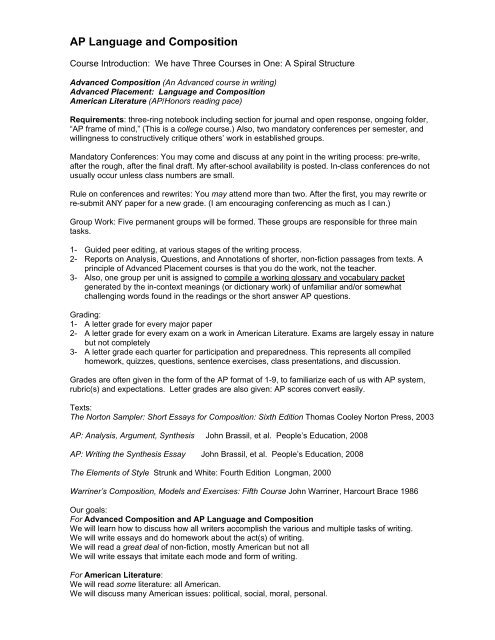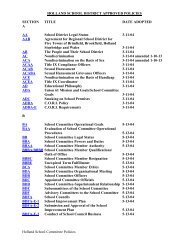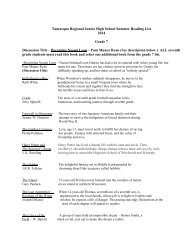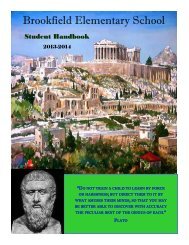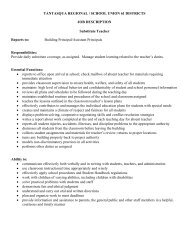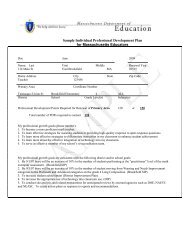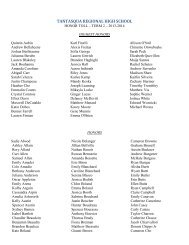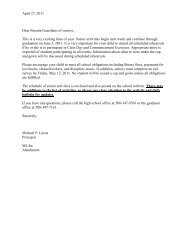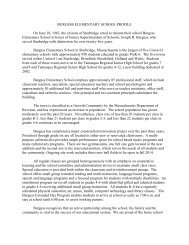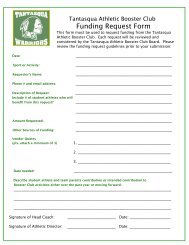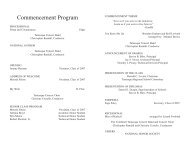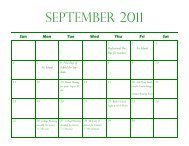AP Language and Composition - Tantasqua.org
AP Language and Composition - Tantasqua.org
AP Language and Composition - Tantasqua.org
You also want an ePaper? Increase the reach of your titles
YUMPU automatically turns print PDFs into web optimized ePapers that Google loves.
<strong>AP</strong> <strong>Language</strong> <strong>and</strong> <strong>Composition</strong><br />
Course Introduction: We have Three Courses in One: A Spiral Structure<br />
Advanced <strong>Composition</strong> (An Advanced course in writing)<br />
Advanced Placement: <strong>Language</strong> <strong>and</strong> <strong>Composition</strong><br />
American Literature (<strong>AP</strong>/Honors reading pace)<br />
Requirements: three-ring notebook including section for journal <strong>and</strong> open response, ongoing folder,<br />
“<strong>AP</strong> frame of mind,” (This is a college course.) Also, two m<strong>and</strong>atory conferences per semester, <strong>and</strong><br />
willingness to constructively critique others’ work in established groups.<br />
M<strong>and</strong>atory Conferences: You may come <strong>and</strong> discuss at any point in the writing process: pre-write,<br />
after the rough, after the final draft. My after-school availability is posted. In-class conferences do not<br />
usually occur unless class numbers are small.<br />
Rule on conferences <strong>and</strong> rewrites: You may attend more than two. After the first, you may rewrite or<br />
re-submit ANY paper for a new grade. (I am encouraging conferencing as much as I can.)<br />
Group Work: Five permanent groups will be formed. These groups are responsible for three main<br />
tasks.<br />
1- Guided peer editing, at various stages of the writing process.<br />
2- Reports on Analysis, Questions, <strong>and</strong> Annotations of shorter, non-fiction passages from texts. A<br />
principle of Advanced Placement courses is that you do the work, not the teacher.<br />
3- Also, one group per unit is assigned to compile a working glossary <strong>and</strong> vocabulary packet<br />
generated by the in-context meanings (or dictionary work) of unfamiliar <strong>and</strong>/or somewhat<br />
challenging words found in the readings or the short answer <strong>AP</strong> questions.<br />
Grading:<br />
1- A letter grade for every major paper<br />
2- A letter grade for every exam on a work in American Literature. Exams are largely essay in nature<br />
but not completely<br />
3- A letter grade each quarter for participation <strong>and</strong> preparedness. This represents all compiled<br />
homework, quizzes, questions, sentence exercises, class presentations, <strong>and</strong> discussion.<br />
Grades are often given in the form of the <strong>AP</strong> format of 1-9, to familiarize each of us with <strong>AP</strong> system,<br />
rubric(s) <strong>and</strong> expectations. Letter grades are also given: <strong>AP</strong> scores convert easily.<br />
Texts:<br />
The Norton Sampler: Short Essays for <strong>Composition</strong>: Sixth Edition Thomas Cooley Norton Press, 2003<br />
<strong>AP</strong>: Analysis, Argument, Synthesis John Brassil, et al. People’s Education, 2008<br />
<strong>AP</strong>: Writing the Synthesis Essay John Brassil, et al. People’s Education, 2008<br />
The Elements of Style Strunk <strong>and</strong> White: Fourth Edition Longman, 2000<br />
Warriner’s <strong>Composition</strong>, Models <strong>and</strong> Exercises: Fifth Course John Warriner, Harcourt Brace 1986<br />
Our goals:<br />
For Advanced <strong>Composition</strong> <strong>and</strong> <strong>AP</strong> <strong>Language</strong> <strong>and</strong> <strong>Composition</strong><br />
We will learn how to discuss how all writers accomplish the various <strong>and</strong> multiple tasks of writing.<br />
We will write essays <strong>and</strong> do homework about the act(s) of writing.<br />
We will read a great deal of non-fiction, mostly American but not all<br />
We will write essays that imitate each mode <strong>and</strong> form of writing.<br />
For American Literature:<br />
We will read some literature: all American.<br />
We will discuss many American issues: political, social, moral, personal.
From Advanced <strong>Composition</strong>:<br />
The four modes of rhetoric: description, narration, exposition, <strong>and</strong> argumentation<br />
Mechanics <strong>and</strong> style: cleaning up your errors, questions, <strong>and</strong> style problems<br />
From <strong>AP</strong> <strong>Language</strong> <strong>and</strong> <strong>Composition</strong><br />
<strong>AP</strong> <strong>Language</strong> <strong>and</strong> <strong>Composition</strong>: Reading <strong>and</strong> Writing: One examines the different forms,<br />
purposes, <strong>and</strong> methods of various types of writing: exposition <strong>and</strong> process essays, arguments, nonfiction<br />
narration, description, journalism, memoirs, <strong>and</strong> mixed versions of the above <strong>and</strong> then writes<br />
essays about non-fiction works, your analysis of those works, <strong>and</strong> your responses to the topics they<br />
raise. For the last, we use specific prompts to stimulate your own thinking <strong>and</strong> make your writing more<br />
developed, accurate, refined <strong>and</strong> mature.<br />
See the more extensive Goals of the <strong>AP</strong> Element of the Course in the preview below.<br />
From American Literature: This course contains great works you should not miss in a high school<br />
career. While the first purpose of the course is to examine writing, the ideas of “the American<br />
experience” <strong>and</strong> of “American values” will become a second theme <strong>and</strong> direction of the course. I<br />
believe this will be of great benefit to us, giving us an alternate way to exp<strong>and</strong>, connect <strong>and</strong> develop<br />
ideas <strong>and</strong> experience as they emerge in the course.<br />
This Boy’s Life<br />
The Awakening<br />
Stories: In Our Time<br />
The Great Gatsby<br />
Death of a Salesman<br />
Huckleberry Finn<br />
Wolff (summer reading)<br />
Chopin<br />
Hemingway<br />
Fitzgerald<br />
Miller<br />
Twain<br />
Also, we will read much non-fiction that is lasting American literature: Essays, memoirs, <strong>and</strong> speeches<br />
by Franklin, Edwards, Emerson, Thoreau <strong>and</strong> many contemporary American non-fiction writers.<br />
NOTE: Exams on the literature will feature in-class essays. You should arrive to the exam with an<br />
outline, write a rough draft in class <strong>and</strong> then complete the essay within 48 hours. You will be your own<br />
editor for these essays. These may be rewritten yet again, but only after conferences.<br />
However, “Major Papers”1-10 below will go through several drafts, using many methods of improving<br />
them: peer <strong>and</strong> group consultation, process writing, conferencing, <strong>and</strong> teacher feedback.<br />
Note: This Preview below exp<strong>and</strong>s our mutual expectations regarding the Advanced Placement<br />
<strong>Language</strong> <strong>and</strong> <strong>Composition</strong> portion of the course:<br />
Preview: How will we spend class-time <strong>and</strong> homework between papers We will look at over 30<br />
pieces of contemporary non-fiction, several works of “literary” non-fiction, four novels, several stories<br />
<strong>and</strong> a play. Each day, we will be moving toward the stated goals of the <strong>AP</strong> <strong>Language</strong> <strong>and</strong> <strong>Composition</strong><br />
Course Guide, which are repeated here for your greater underst<strong>and</strong>ing. Our methods of achieving<br />
those goals appear in italics following the stated goal. Again, the goals, bulleted, are from the official<br />
<strong>AP</strong> Course Description for Advanced Placement: English <strong>Language</strong> <strong>and</strong> <strong>Composition</strong>.<br />
• analyze <strong>and</strong> interpret samples of good writing, identifying <strong>and</strong> explaining an author’s use of rhetorical<br />
strategies <strong>and</strong> techniques:<br />
We will be using models, journals, questions, analysis, class <strong>and</strong> group discussion to define, identify<br />
<strong>and</strong> apply the elements of “rhetorical strategies.” Note that acquiring <strong>and</strong> then being able to discuss<br />
<strong>and</strong> use the knowledge of rhetoric is one of our primary tasks of the course.<br />
• apply effective strategies <strong>and</strong> techniques in their own writing.<br />
With all 10 papers, we will have one or more skill focus reflected in pre-writing instruction <strong>and</strong> rubrics.<br />
The course aims to improve your writing in every way.<br />
• create <strong>and</strong> sustain arguments based on readings, research, <strong>and</strong>/or personal experience;
We will write three argument papers, one personal, <strong>and</strong> shorter pieces of argumentation. We begin the<br />
course with argument, as it is the mode most suitable to identifying the nature <strong>and</strong> specifics of the<br />
rhetorical process.<br />
• write for a variety of purposes : see assignments list<br />
• produce expository, analytical, <strong>and</strong> argumentative compositions that introduce a complex central<br />
idea <strong>and</strong> develop it with appropriate evidence drawn from primary <strong>and</strong>/or secondary sources, cogent<br />
explanations <strong>and</strong> clear transitions<br />
With class <strong>and</strong> teacher feedback, your writing will improve in depth <strong>and</strong> complexity. You will look for<br />
clear cues in the question or prompt to learn exactly what task you are being asked to perform. This is<br />
an extension of the nature of the “Four Modes of Rhetoric” approach.<br />
We learn both the “Macro” element of looking at one’s own work as a whole (purpose, <strong>org</strong>anization,<br />
thesis, audience) <strong>and</strong> the “Micro” level of controlling paragraphs, offering evidence, providing<br />
transitions, crafting sentences, <strong>and</strong> connecting paragraphs for lucidity.<br />
We emphasize that writing <strong>and</strong> planning in paragraphs in the central skill of the course. Examining <strong>and</strong><br />
creating richer <strong>and</strong> more unified paragraphs is the key to the improvement of writing.<br />
• demonstrate underst<strong>and</strong>ing <strong>and</strong> mastery of st<strong>and</strong>ard written English as well as stylistic maturity in<br />
their own writings:<br />
Teacher feedback <strong>and</strong> The Elements of Style are used to correct any mechanical errors as well as to<br />
begin conversations on style. Essays are kept in a folder so the teacher can have “a conversation”<br />
with <strong>and</strong> about a student’s body of work. Sentence exercises are practiced with some regularity.<br />
Vocabulary: Students will compile weekly vocabulary lists from problematic or what we call “SAT”<br />
words: the lists should number between 30 <strong>and</strong> 75. One group will have this responsibility per unit, but<br />
will run off a Vocabulary Packet for the entire class on that unit.<br />
Packets should contain a clear <strong>and</strong> user-friendly definition of the word, then offer three words from a<br />
thesaurus that are related but not identical in meaning.<br />
Students are to expect a vocabulary quiz, unannounced, a few days after the packets are produced.<br />
• demonstrate underst<strong>and</strong>ing of the conventions of citing primary <strong>and</strong> secondary sources;<br />
On a final research paper, we use Purdue’s The Owl <strong>and</strong> The Big Six (an approach to research<br />
generally, then applying the MLA method) provided by the school library,<br />
• move effectively through the stages of the writing process, with careful attention to inquiry <strong>and</strong><br />
research, drafting, revising, editing, <strong>and</strong> review<br />
Lessons, brainstorming devices, approaches to “getting it going,” peer-editing, conferencing, selfassessment,<br />
<strong>and</strong> teacher feedback are all designed to deepen your experience <strong>and</strong> expertise as a<br />
writer. You will see a paper as a finished product that emerges from an ongoing process to improve it.<br />
• write thoughtfully about their own process of composition<br />
Journal <strong>and</strong> peer response ask you to comment on your own development<br />
• revise a work to make it suitable for a different audience:<br />
We practice discourse activities that alter with an audience’s needs or knowledge base. The major<br />
paper in middle of the course addresses the issue of audience directly.<br />
• analyze image as text
Photographs accompany each unit <strong>and</strong> are seen as “texts” to be brought to bear on the subject. Films<br />
<strong>and</strong> videos present numerous points of view in a confined amount of time. <strong>AP</strong> students are expected<br />
to listen to literary critics or other non-fiction oral or visual sources with accuracy <strong>and</strong> receptiveness.<br />
• evaluate <strong>and</strong> incorporate reference documents into researched work<br />
Your last paper involves research <strong>and</strong> incorporation of that research into a final work of your own.<br />
UNITS of the course:<br />
Unit A: 2 weeks<br />
Introduction to Rhetoric through Introduction to Argument;<br />
Introduction to Annotating Texts;<br />
Introduction to Analysis using Terminology of the Rhetorical Tool Kit<br />
Opening Topics:<br />
“Everything’s an Argument” What does that mean Is it true<br />
The Four Modes of Rhetoric: The Norton Sampler introduction<br />
The Rhetoric Triangle <strong>and</strong> “SO<strong>AP</strong>STONE” Brassil packet <strong>and</strong> notes<br />
TRACE arguments “ “ “<br />
Aristotle, Cicero <strong>and</strong> the Classic Argument<br />
Materials:<br />
“Closing the Plant” Two speeches from the film “Other People’s Money”<br />
Othello, Obama <strong>and</strong> the Lies that Kill: play review <strong>and</strong> column Joe Earls<br />
Inaugural Address John F. Kennedy<br />
Two Letters from <strong>AP</strong> “Special Focus on Writing Persuasively”<br />
Analysis, annotation, <strong>and</strong> discourse activities:<br />
• re-examine <strong>and</strong> establish “purpose” as the overriding issue in all pieces of rhetoric<br />
• identify <strong>and</strong> discuss the basic three-step classic argument: introduction, refutation, proposition (with<br />
reasons building to the conclusion). Compare the two speeches, yet see their common “shape.”<br />
• discuss <strong>and</strong> identify the psychological <strong>and</strong> emotional elements of argument<br />
• watch Gregory Peck <strong>and</strong> Danny Devito deliver the speeches <strong>and</strong> comment on the effect of the added<br />
visual element of body language <strong>and</strong> voice<br />
• Annotate completely the Othello/Obama review. Discuss the nature, purpose, <strong>and</strong> importance of<br />
annotation.<br />
• identify the rhetorical strategies of Kennedy’s address: ethos, pathos, logos, <strong>and</strong> then his language<br />
devices: antithesis, parallel structure, metaphor, rhetorical questions, alliteration.<br />
• Rewrite Kennedy’s speech with all language devices omitted, in order to notice <strong>and</strong> examine then.<br />
(“Pay any price, bear any burden” becomes “Pay anything, take on all responsibility,)<br />
• Diction <strong>and</strong> Tone: Students do objective questions <strong>and</strong> then discuss strategies from <strong>AP</strong> exam<br />
material: Seaver's <strong>and</strong> Herbert’s letters that dispute “It’s the Real Thing” slogan.<br />
Sentences, Grammar, <strong>and</strong> Style:<br />
o The Elements of Style Strunk <strong>and</strong> White: Rules 1-6<br />
o Warriner’s practice exercises: Loose <strong>and</strong> Periodic Sentences, Parallel Structure<br />
o Group 1: Vocabulary List from all texts of problematic vocabulary, presented as a packet<br />
Major Paper 1: Write an Argument concerning the hypothetical choice between completely<br />
funding or eliminating either music or athletics in our high school.<br />
The audience is an undecided school committee. Students need to use rhetorical strategies at<br />
the “macro” level (ethos, pathos, logos, the classic argument structure) <strong>and</strong> at the “micro”<br />
level, with language strategies <strong>and</strong> emphasis on tone <strong>and</strong> persuasion.
Unit B: The Nature of Voice <strong>and</strong> the Writer’s Duty: 2 weeks<br />
This Boy’s Life Tobias Wolff (Assigned as Summer Reading)<br />
On Keeping a Notebook Joan Didion<br />
From “An American Childhood” Annie Dillard<br />
Nobel Prize Address<br />
William Faulkner<br />
“The Stranger in the Photo is Me” Donald M. Murray<br />
Analysis, annotation, <strong>and</strong> discourse activities:<br />
• Journal: Wolff read as “fiction” then when you realized it is not – what occurred How is it not a diary<br />
Not a history The “crafted” aspects on non-fiction introduced <strong>and</strong> explored.<br />
• Examine each sentence of pages 1-4 in This Boy’s Life <strong>and</strong> report on what the sentence “does.”<br />
• Fill out SO<strong>AP</strong>STONE worksheet on Faulkner’s speech. What is revealed More than a “Thank you!”<br />
• Says/Does Analysis: Identify each audience implied in Faulkner’s Address: What are Faulkner’s<br />
agenda(s) for each audience How do the sentences achieve them<br />
• Bring in <strong>and</strong> show one personal photo. One partner writes impressions before any dialogue. Discuss<br />
impressions, photos, <strong>and</strong> then trade papers. Writer then amplifies on his photograph based on<br />
discussion as well as his own observances.<br />
Sentences, Grammar, <strong>and</strong> Style:<br />
o The Elements of Style Strunk <strong>and</strong> White: Rules 7-11<br />
o Teacher designed “point of view” exercise(s)<br />
o Warriner’s Sentences: Formal <strong>and</strong> Informal Styles<br />
o Group 2: Vocabulary List from all texts of problematic vocabulary, presented as a packet<br />
Major Paper 2: Write a Memoir of an episode in your life that “fulfills the writer’s duty.”<br />
Papers are expected to narrate the memory successful but provide a thematic element<br />
to your choice, as Dillard did.<br />
Unit C: War 3 ½ weeks<br />
10 Stories from In Our Time Ernest Hemingway<br />
Opening speech of “Patton”<br />
Ge<strong>org</strong>e C. Scott as General Patton<br />
Speech Before Battle<br />
Cataline<br />
Message to Invasion Troops<br />
Dwight D. Eisenhower<br />
Photograph of Invasion Troops Franklin D. Roosevelt Library: untitled photograph<br />
Commencement Address<br />
General Douglas MacArthur<br />
War is Not a Biological Necessity Margaret Mead<br />
On War<br />
James Boswell<br />
The Lion in Winter<br />
Sebastian Junger<br />
Agincourt Speech… From Henry V<br />
Grant <strong>and</strong> Lee at Appomattox Bruce Catton<br />
Analysis, annotation, <strong>and</strong> discourse activities:<br />
• Analytical <strong>and</strong> Rhetorical Strategy questions chosen from Brassil’s text continue to both<br />
deepen the need <strong>and</strong> hone the skills to read closely<br />
• Groups develop expertise in presenting the text annotated <strong>and</strong> re-read, continuing to<br />
emphasize rhetorical strategies.<br />
• Brassil’s unit questions are comprehensive but all always about “the text” <strong>and</strong> require students<br />
to be able to discuss subtle differences <strong>and</strong> strategies of these similar pieces.<br />
• Response: Why does Junger change his point of view halfway through the piece What does<br />
it mean<br />
• Response: How does the film use the first presentation of Patton to begin an argument in<br />
favor of the notion of the heroic <strong>and</strong> for the necessity of cultivating a capacity to wage war.<br />
• SO<strong>AP</strong>stone Henry V from his first line: note ethos, subtle changes in pathos, extended<br />
number of logos points made. Besides blank verse, what other language <strong>and</strong> oratorical<br />
devices does Shakespeare use to make this speech effective
Sentences, Grammar, <strong>and</strong> Style<br />
o The Elements of Style Rules 9-14<br />
o Warriner’s: Complex, Compound, <strong>and</strong> Simple Sentences<br />
o Group 3: Vocabulary List from all texts of problematic vocabulary, presented as a packet<br />
Test essay: Exposition: Identify one Hemingway story as a “typical Hemingway story,” by defining<br />
what that is, then do a literary analysis on the same story showing its unique nature <strong>and</strong> compared to<br />
the other nine stories.<br />
“Halftime”: Review <strong>and</strong> Clarification in preparation for Major Paper 3<br />
“The Rhetorical Toolkit” What is in yours now (Packet compiled from <strong>AP</strong> week-long workshop,<br />
Brassil h<strong>and</strong>out material, further research <strong>and</strong> class notes.)<br />
“What do Students Need to Know about Rhetoric” Hepzibah Kelly<br />
Major Paper 3: In class <strong>AP</strong> test preparation model (timed) as a culmination of Argument <strong>and</strong><br />
Rhetorical Strategies Introduction Unit: Analyze the rhetorical strategies of Henry V’s<br />
Agincourt speech. Counts as a paper.<br />
Major Paper 4: Compare <strong>and</strong> Contrast the purpose, content <strong>and</strong> rhetorical devices in two<br />
writers/speakers in the “War” unit.<br />
Major Paper 5: First Synthesis Assignment. Using the prompt from Brassil’s Synthesis<br />
Workbook, argue whether war is part of the method of its eventual elimination or an<br />
unavoidable part of the human condition.<br />
Unit D: Gender <strong>and</strong> Identity 3 weeks<br />
The Awakening<br />
Kate Chopin<br />
“Romantic Imagery in The Awakening” Donald Ringe (critical essay)<br />
Test Essay: Process : Discuss the process by which Edna Pontellier strives to define herself<br />
as a woman <strong>and</strong> “awaken.” Consider the realist <strong>and</strong> romantic elements detailed by Chopin.<br />
Discuss her suicide as a completion or a negation of the process.<br />
What is Beauty <strong>and</strong> How Do We Know It Nancy Ethoff<br />
Hope <strong>and</strong> History in a Jar<br />
Kathy Peiss<br />
Various Photographs:<br />
Marilyn Monroe, African Princess<br />
Professions for Women Virginia Woolf<br />
Gender in the Classroom Deborah Tannen<br />
Guys vs. Men<br />
Dave Barry<br />
How Boys Become Men Jon Katz<br />
Bill Moyers <strong>and</strong> Robert Bly (interview)<br />
from Iron John<br />
Robert Bly<br />
• Analysis, annotation, <strong>and</strong> discourse activities:<br />
• Explicate the descriptive elements <strong>and</strong> their character implications during Edna’s<br />
sensual awakening scene at Mme. Antoine’s<br />
• Do the discourse activities in Brassil ’s text with Marilyn Monroe <strong>and</strong> the Swahili<br />
princess: group discussion follows<br />
• Journal <strong>and</strong> debate Tannen’s thesis <strong>and</strong> solution: what has been your own<br />
observation. Then, your own experience<br />
• Journal Response (private); In what ways do Bly <strong>and</strong> Moyer reflect the problems <strong>and</strong><br />
desires of your own fathers or stepfathers
• Free writing: Iron John, mentors <strong>and</strong> the “guys” you know<br />
• What serious points underlie Barry’s humor What are his methods of humor If<br />
“everything is an argument”, what is his<br />
• Descriptive Writing: “An Attractive Person Enters a Room” Do two drafts: The second<br />
must be shorter than the first <strong>and</strong> you must explain to a partner how these changes<br />
improve the paper.<br />
Sentences, Grammar, <strong>and</strong> Style:<br />
o The Elements of Style: Rules 15-18<br />
o Warriner’s: Varying Sentence Length; Varying Sentence Beginnings<br />
o Group 4: Vocabulary List from all texts of problematic vocabulary, presented<br />
as a packet<br />
Major Paper : Course Culmination, first half: Gender Paper # 2.<br />
This is your first self-generated non-fiction work, asking that you apply all the rhetorical modes,<br />
rhetorical strategies, stylistic <strong>and</strong> the sentence skills in the curriculum so far. You must generate your<br />
own prompt. You may write on any one of the following topics/titles below. The challenge will be to find what<br />
your “take” on the topic will be. What angle will you explore, from what direction Here are six possible<br />
“Titles.” Given the nature of your choices of prompt, the only criterion is that the prompt you write fits the given<br />
title, however you choose to interpret the title.<br />
1. From ‘Tween to Teen….<br />
2. The Process So far: Becoming a Man/Woman in America<br />
3. What Do they Teach Teens: What Do We Learn<br />
4. An Argument against Gender: Closing the Great Divide<br />
5. What They Don’t Know About Us<br />
6. The Mentor<br />
Before the planning <strong>and</strong> writing begins:<br />
• First, what will be your audience This will shape your entire piece.<br />
• How will you make it interesting, compelling, <strong>and</strong> possibly original. Could this be a<br />
submission piece To whom Drawing on your own voice <strong>and</strong> experience.(You may assume<br />
a reader who is interested <strong>and</strong> not as knowledgeable as you are.)<br />
• Voice: How much ethos will you use How often will you use the first person (Is there a<br />
danger of too often) Will you use the editorial “we” (That is, speak as a teenager A girl A<br />
female ) Or will you be totally objective, a 3 rd person point of view, so that we can’t tell the<br />
age or gender of who wrote the piece<br />
• Also, what mode of rhetoric will you take That is, will you make an Argument, explore an<br />
Expository task (Do an Analysis or a Process or a Compare <strong>and</strong> Contrast) or even write a<br />
Narrative or Description that has sufficient weight<br />
• Will you use any sources, even briefly (If so, do a Works Cited page.)<br />
Unit F: Nature <strong>and</strong> the Individual Soul: 2 weeks<br />
Self Reliance, Address at Harvard Divinity<br />
Walden Selections: Economy, Where I Lived <strong>and</strong><br />
What I Lived For, Brute Neighbors<br />
Selection: Pilgrim at Tinker Creek<br />
The Death of a Moth<br />
How I Wrote The Moth Essay---And Why<br />
R.W. Emerson<br />
Henry David Thoreau<br />
Annie Dillard<br />
Annie Dillard<br />
Annie Dillard
Analysis, annotation, <strong>and</strong> discourse activities:<br />
• “Honor “ a single sentence of Emerson’s with an image or series of images, then present the<br />
sentence <strong>and</strong> the image to class.<br />
• Explicate, word for word, the ..”I went to the woods…” paragraph in Chapter Two of Walden<br />
• Brainstorm a presentation regarding every difference possible between the essays that begin<br />
with the deaths of two moths in two separate essays by the same writer<br />
• Contrast Thoreau’s stated reasons for writing with Dillard’s. What attracts you to either of<br />
them What specifically puts you off In what ways<br />
• Journal: Why do YOU write How has your relationship to your writing changed since the<br />
course began<br />
Sentences, Grammar, <strong>and</strong> Style<br />
o<br />
o<br />
o<br />
The Elements of Style: “An Approach to Style”<br />
Warriner’s: The Clincher Sentence<br />
Group 5: Vocabulary List from all texts of problematic vocabulary, presented as a packet<br />
Major Paper 7: Personal Essay: Discuss two ideas: Reflection <strong>and</strong> Conformity OR Reflection<br />
<strong>and</strong> Solitude. Establish a thesis in any mode (argument, analysis, narrative, descriptive) <strong>and</strong><br />
develop the paper.<br />
Unit G: American Dream(s), American Myths 3 weeks<br />
The Great Gatsby F. Scott Fitzgerald<br />
Video: Great Books: The Learning Channel: The Great Gatsby<br />
Video: “This Side of Paradise” Biography of F. Scott Fitzgerald<br />
Jazz Nat Henthoff<br />
Video: sections Jazz Ken Burns<br />
Test Essay: Title: “The Past in Fitzgerald <strong>and</strong> Gatsby”. Narrow your focus so that you can<br />
write your own thesis <strong>and</strong> complete the essay in the allotted time.<br />
Autobiography (“selection”) Ben Franklin<br />
“Sinners in The H<strong>and</strong>s of An Angry God “ Jonathan Edwards<br />
The Rise of the Blended American Jeff Jacoby<br />
What is an American Michel-Guillaume-Saint-Jean de Crevecoeur<br />
Speech at 2004 Democratic Convention Barack Obama<br />
Death of a Salesman Arthur Miller<br />
On Tragedy<br />
Arthur Miller<br />
Analysis, annotation, <strong>and</strong> discourse activities:<br />
• Respond to the use of the first person point of view in the opening chapter of Gatsby.<br />
Compare it to other uses of the “I” so far in the course.<br />
• List the sources of insight <strong>and</strong> comment in both videos concerning Fitzgerald. Go on-line <strong>and</strong><br />
find out more information about the speaker’s connection to Fitzgerald <strong>and</strong> his work.<br />
• Note the amount of information <strong>and</strong> number of sources Burns uses in 25 minutes<br />
Evaluate any two of them. If Burns had to cut the source from the final print of the film, what<br />
do we lose<br />
• “To someone who knows nothing about jazz”….a 1 ½ page précis from Henthoff <strong>and</strong> Burns.<br />
• Jacoby <strong>and</strong> Crevecoeur: 200 years, but then, how far apart Compare thesis <strong>and</strong> backing<br />
points<br />
• Comment on the subtext <strong>and</strong> intended audience of “On Tragedy” Why is Miller trying so hard<br />
Major Paper 8: Analysis into Synthesis. No idea in literature is so discussed as “The American<br />
Dream.” Using three sources, write a synthesis paper that explores your thesis regarding the<br />
American Dream as it currently exists (or exists in myth or memory) in our culture.
Unit H : Wit<br />
2 weeks<br />
Huckleberry Finn (Chapters 1-19)) Mark Twain<br />
Two views of Huckleberry Finn: Jane Smiley <strong>and</strong> T.S. Eliot<br />
Mark Twain: Documentary Ken Burns … 20 minutes on the novel<br />
James Fenimore Cooper ‘s Literary Offenses Twain<br />
Two Letters, Both Open: E.B. White<br />
A Modest Proposal Jonathan Swift<br />
Girl Moved To Tears By Of Mice <strong>and</strong> Men Cliff Notes The Onion<br />
Analysis, annotation, <strong>and</strong> discourse activities:<br />
• Find 5 “funny things” in the first chapter of Huckleberry Finn. What effect does the laughter<br />
have What information about Huck <strong>and</strong> his situation do they convey<br />
• Group work: Go beyond “funny.” Compile a list of terms to be used in discussing humor in<br />
writing. These may be sub-genres (satire), devices (incongruity), or effects (irony).<br />
• With certainty, discuss the various purposes of each of the humorous pieces.<br />
Sentences, Grammar, <strong>and</strong> Style<br />
o<br />
The Elements of Style: “Words <strong>and</strong> Expressions Easily Confused”<br />
Major Paper 9: Irony, Satire, Sarcasm, Parody, Disillusionment: Choose any contemporary<br />
issue or “sacred cow” in our society – including great works of literature or great events—<strong>and</strong><br />
use various forms of wit to accomplish a specific goal, to be determined by you.<br />
Unit I<br />
Heroes: A Synthesis <strong>and</strong> Research Unit 1 ½ weeks<br />
• “Poem to Frederick Douglas” Robert Hayden<br />
• “Mrs. Robinson” Simon <strong>and</strong> Garfunkel<br />
• “Baseball” by Ken Burns…Jackie Robinson, Joe Dimaggio sections<br />
• ESPN article on Larry Doby, 2nd black in majors<br />
Major Paper 10: Final Assignment : 1 week<br />
Research four sources, document them properly, <strong>and</strong> develop an <strong>AP</strong> Synthesis researched<br />
essay on a chosen hero <strong>and</strong>/or the notion of the “heroic” in American Life.<br />
Analysis, annotation, <strong>and</strong> discourse activities:<br />
• Review MLA methods with h<strong>and</strong>outs from Freshman English <strong>and</strong> department<br />
• Listen to librarian’s in-house lesson on research: “The Big Six” h<strong>and</strong>out, <strong>and</strong> going<br />
beyond the Web.<br />
• Visit, explore, master: Owl Website, Purdue University<br />
http://owl.english.purdue.edu/owl/resource/675/01/


